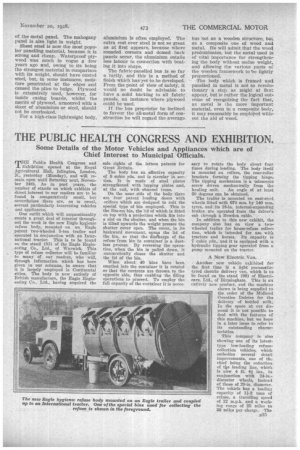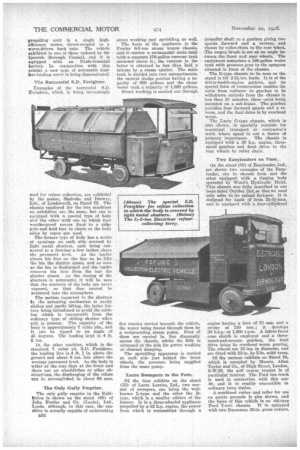THE PUBLIC HEALTH CONGRESS AND EXHIBITION.
Page 31

Page 32

If you've noticed an error in this article please click here to report it so we can fix it.
Some Details of the Motor Vehicles and Appliances which are of Chief Interest to Municipal Officials.
TFIE Public Health Congress and Exhibition opened at the Royal Agricultural Hall, Islington, London, N., yesterday (Monday), and will remain open until Saturday next, November 24th. As in past years, the number of stands on which exhibits of direct interest to our readers are to be found is comparatively small, but nevertheless there are, as is usual, several particularly interesting vehicles and appliances.
One outfit which will unquestionably create a great deal of interest throughout the week is the new Eagle hygienic refuse body, mounted on an Eagle patent two-wheeled 5-ton trailer and 'operated in conjunction with an International tractor. This is to be found on the stand (93) of the Eagle Engineering Co., Ltd., of Warwick. This type of refuse collector will be familiar to many of our readers, who will, through information which has been given in our columns, be aware that it is largely employed in Continental cities. The body is new entirely of British manufacture, the Eagle Engineering Co., Ltd., having acquired the
sole rights of the letters patents for Great Britain.
The body has an effective capacity of 8 cubic yds. and is circular in section. It is made of steel plates strengthened with lapping plates and, at the end, with channel irons.
On the near side of the body there are four patent loading doors with orifices which are designed to suit the special type of bin employed. This is the Ess-em bin, the lid of -which is fitted on top -with a projection which fits into a slot on the shutter, and when the bin is tilted upwards the weight presses the shutter cover open. The cover, in its backward movement, opens the lid of the bin, so that the diselarge of the refuse from bin to container is a dustless process. By reversing the operation, when the bin is pulled down, it automatically closes the shutter and the lid of the bin.
When about 40 bins have been emptied into the container it is rotated so that the contents are thrown to the opposite side, thus enabling the Ailing operations to proceed. To employ the full capacity of the container it is neees
sarY to rotate the body about four times during loading. The body itself is mounted on rollers, the rear-roller brackets forming the tipping hinge. The tipping mechanism is a telescopic screw driven mechanically from the
hauling unit. An angle of at least 50 degrees can be obtained.
The trailer is mounted on cast-steel wheels fitted with 670 mm. by 140 rem. tyres, audits 18-in. internal-expanding brakes are operated from the driver's cab through a Bowden cable.
In addition to this new exhibit, the company also has on view a twowheeled trailer for house-refuse collection, which is intended for use witli tractors and horses. Its capacity is 7 cubic yds., and it is equipped with a hydraulic tipping gear operated from a pump mounted on the tractor.
A New Electric Van.
Another new vehicle exhibited for the first time is a light pneumatictyred electric delivery van, which is to be found on the stand (99) of Electricars, Ltd., of Birmingham. This is an entirely new product, and the machine shown is beine-b supplied to the order of the Midland Counties Dairies for the delivery of bottled milk. In the space at our disposal it is not possible to deal with the features of this machine, but we hope in a later issue to refer to its outstanding characteristics.
This company is also showing one of its latesttype low-loading refusecollection vehicles, which embodies several detail improvements, one of the chief being the reduction of tip loading line, whice is nOw 4 ft. 4 ins., in conjunction with 24-in.diameter wheels, instead of those of 20-in. diameter. The vehicle has a loading capacity of 1i-2 tons of refuse, a travelling speed of 12 m.p.h. and a working range of 25 miles to 30 miles per charge. The
propelling unit is a singlehighefficiency motor, direct coupled to a worm-driven back axle. The •vehicle exhibited is one of three ordered by the Ipswich Borough Council, and it is equipped with an Exide-lronelad battery. In emijunctien with. this exhibit a-new type of automatic dustless-losding cover is being demonstrated.
The SuccessfulS.D. Freighter.
Examples of the successful S.D. Freighter, which is being iurreasingly
used for refuse collection, are exhibited by the maker, Shelveke and Drewry, Ltd., of Letchworth, on Stand 72. The chassisemployed for the two machines on exhibition are the same, but one is equippedwith a special type of body andthe other with one in which four -weatherproof covers 'fixed ta it ridge pole and held fast to cleatson the body side& by ropes are. used.
The former tyPe of body hasa 'series
01 openings on each side covered by light metalshutters, each being connected to a foot-bar a. few inchesabove the pavereett level. As the loader places his foot on the bar as he lifts the 'bin the shutter opens, and so 'soon as the bin is discharged and the. loader removes his foot from thc bar the shutter chases: • As the closing of the shutters is automatic, it will be seen that the contents of the body axe never exposed, so -that they cannot be scattered into the atmosphere.
The motion imparted to the shutters by the actuating mechanism is partly sliding and partly lifting, thit latter feature being introduced to avoid the sticking which is inseparable from the ordinary type of sliding shutter when grit is present. The capacity of the body is approximately 7 cubic yds., and it can be tippred to an angle of 45 degrees: The loading level is -4 ft.
2 ins.
In the other machine, which is the standard 7 cubic yd. S.D. Freighter, the loading line is 4 ft. 1 in. above the grrnind and a-bout 6 ins, less above the average pavement level. As the body is wider at the rear than at the front and there are nowheelarches or other obstructions, the, discharging of the refuse can be accomplished in about 90 sees., The Onryy. Gully Emptier.
The only gully emptier in the Exhibition is shown on the stand (98) of Sohn Fowler and Co. (Leeds), Ltd:, Leeds, although, in this case, the machine is actually capable of undertaking 1336 street washing and sprinkling as well. The basis of the appliance is the Fowler 6-7-ton steam wagon chassis, and it carries a rectangular main tank • with, a separate. 170-gallon vacuum tank mounted above it ; the vacuum in the latter is obtained in less than half a minute by a steam ejector. The main tank isdivided into two compartments, the central sludge portion having a capacity of 900 gallons and the cleanwater tank a capacity of 1,020 gallons.
Street washing is carried out through five nozzles carried beneath the vehicle, the water being forced through them by a reciprocating steam pump. Four of them are carried in line diagonally across the chassis, whilst the fifth is arranged at the side for gutter washing or channel damping.
The Esprinkling apparatusis carried at. each side just behind the front wheels, the ,pressure being supplied from the same pump.
Lacre Sweepers to the Fore.
Of the lone exhibits on the stand (75) of Laere Lorries, Ltd., two consist of sweepers, one being the wellknown L-typeand the other the Btype, which is a smaller edition of the former. It is a three-wheeled appliance propelled' bya.12 h;p engine, the power from which is transmitted through a propeller shaftto a gearbox, giving two speeds forward and n reverse; and 'then& by roller-chain to the rear wheel, ,The rotary brush-is set 'at .an angle' be-tween: the front and' rear wheels. The equipment comprises: a 100,gallon water tank with pressure. gear to the sprayers situated in front of the chassis.
The E-type chassis to. be seen on the stand is f6t 2-21-ton loads, It is of the driver-beside-engine pattern, and its special form of construction enables the units from, radiator to . gearbox to be withdrawn entirely from thechassis in less than 10 minutes, these units. being mounted on a sub-frame. The gearbox ptovides four forward speeds and a reverse, and the final, drive Is by overhead
'worm. .
The Lam 0-type chassis, which is also shown, is specially suitable for municipal transport or contractor's work wherespeed. is net a. factor of Primary importance, The chassis is equipped with a 30 h.p. engine, threespeed. gearbox and final drive to the rear wheels by roller chain.
Two Easyloaders on View.
On the stand (83) of Easyloader,Ltd., are shown two examples of the Easyloader, mm in ehasaiS form and. the other equipped with a tipping body operated by Wood's Hydraulic Heist. This chassis -was fully. described in our . issue dated October 2nd, so that we need Only refer to its salient feature's. It is designed for loads of' front 21-8-i4ons, and is equipped with a four-cylindered engine having a bore of 73 men. and a stroke of 130 mm. ; it develops 20. b.h.p. at 1,400 r.p.m. A fabric-faced cone clutch is employed and a threespeed-and-reverse gearbox, the final drive being by overhead worm gearing. The wheels are 16 ins, in diameter, and are fitted with 22-in. by 5-in. solid tyres.
Of the various exhibits on Stand 53, -whiclt is occupied by Messrs. Allan Taylor and Co., of High Street, London, S.W.18, the golf course tractor is of partieular interest. The Ford ton truck is used in connection with this outfit, and it is readily convertible to ordinary lorry duties.
A combinedcutter and roller for use . on sports grounds is also shown, and the basis. ot" this vehicle is an old-type Ford 7-ewt: chassis; it is equipped with two' Ransomes 30-in, grass' cutters.








































